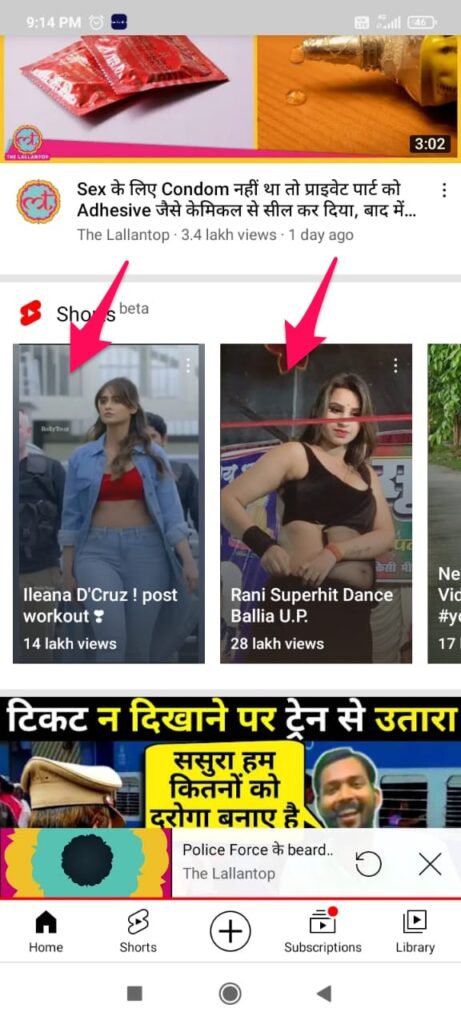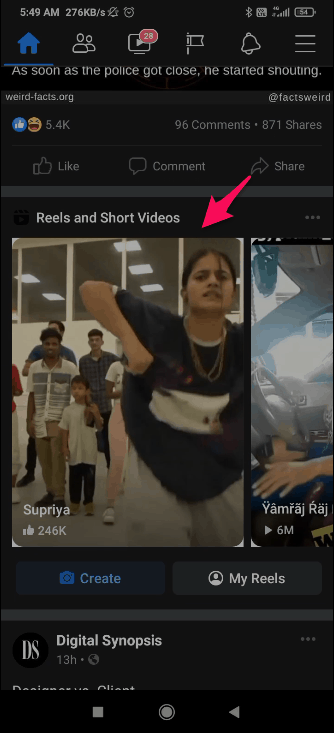In this article, I will uncover the secrets tech companies are using to keep their audience engaged with their product.
Let’s start with Facebook.
As we all know, recently, Facebook, Instagram and Youtube have incorporated short videos in their app To keep their audience spend more time on their platform.
As a regular user, I was also using Facebook and noticed the short videos. It was enjoyable to use at first, but here is the twist.
After a few days of watching short videos, I got so habitual that Whenever I use Facebook, I drew to shorts videos!
What made me habitual of short videos?
It’s the attractiveness of the short videos.
Every time I open Facebook 8 out of 10 times, they show me the preview of a girl doing something in the video.

It’s not only in my FB; I have checked it in my friends and family members’ phone and found that the same thing is also going in their FB account. So, Before talking about Fb, let’s see
How LinkedIn is also using it to achieve their goal
To increase the completion rate of the profile, LinkedIn uses a simple but effective tool: The progress bar. Users see a progress bar that fills up when they add new information to their virtual profile. After successfully entering all relevant data, members also receive a badge – they are now “superstars”.

Through this simple mechanic, LinkedIn increased the rate of full profile completion by 55%. Although this was the example of gamification but, at its core, gamification also uses the principle of “making it attractive”.
Let’s break down how they are using it in their product.
In behavioural science, making things attractive consists of two things. First is grabbing attention, then actually making it attractive.
Grabbing attention is very important. Marketers are hungry for grabbing people attention; the sales guy wants your attention to sell something; politicians want your attention to pitch you why you should vote for them.
Everyone wants your attention because everything starts from your attention.
When something has to stand out: in the language of psychology, it is known as salient. In fact, there is a bias which is known as salience bias. In simple words, salience means something has to stand out from its environment.
Salience can be increased through personalisation, relevance or contrast.
Other examples of salience are: standing out from the background, Changing the colour of an envelope, the use of images or video that can reach out to us on an emotional level;
Remember? When someone calls your name in a crowd, and you started to pay attention to that sound? Addressing a person by name can all increase the impact of communication or intervention.
On Facebook and Youtube, both of them are grabbing attention by showing a girl preview. Although it is salient but, they are also using curiosity here!
Because girls are everywhere, but we don’t pay attention everywhere, they show the previews in which girl is doing something, which makes us curious to click.

.

Once you grabbed the attention…
The second task is to make that thing, offer or product itself attractive, or at least persuasive.
Logically speaking, if something is attractive, it should provide some reward always. A reward could be external or internal.
Examples of External rewards are financial incentives, vouchers and gifts.
Examples of internal rewards are giving someone positive feedback or praising about their looks.
In the case of LinkedIn, they are providing rewards in the form of stars and showing the progress bar (I had shared the image above already).
And in the case of the Facebook sorts video, it is a variable and internal reward(enjoyment when watching those videos), A chemical realise in our brain when we get the reward, know as dopamine.
So far, we have learned that making something attractive should grab the attention first and then make the product or offer attractive.
One last thing, whatever the reward is, it should be immediate.
If you are reading this article so far, you may have noticed that whatever action users are performing, all digital products give immediate rewards in different forms.
Research on why immediate reward can change behaviour

In 2008, a group of researchers from New York State embarked on an ambitious program. They had twenty-four months and $50,000 to enhance hand sanitisation in hospitals significantly. An intensive care unit (ICU) in the northeastern United States was chosen for a case study.
The unit was already equipped with easy-to-use sanitisation-gel dispensers, sinks in every room, and signs everywhere reminding medical staffers that they must wash their hands. Yet compliance was alarmingly low.
What could be done? The team brainstormed for weeks, after which they went out and purchased twenty-one video surveillance cameras.
The cameras were carefully installed in the ICU, pointing toward the gel dispensers and sinks.
The plan was to transmit the recordings live via the Web to India, where twenty auditors would monitor the actions of the medical staff twenty-four/seven to determine the rate of sanitisation.
Doorway motion sensors would alert the auditors in India every time a staff member entered or left a patient’s room.
The medical staff was well aware that they were being watched.
Shockingly, however, even though they knew they were being recorded, only one in ten staff members complied with the handwashing rules.
That meant that surveillance alone was not enough.
The team had to come up with something better. What researchers did next would change the staff’s behaviour almost instantly.
The researchers placed an electronic board in each room, giving the staff immediate feedback on how they were doing.
Every time a doctor, nurse, or other worker washed their hands, the numbers on the board went up.
Also, it indicated how well the current shift was going: what percentage of workers were washing their hands and the weekly rate. What happened after putting the board?
This setup scored almost 90 per cent (means 90% of staff started to wash their hand)! These results are astonishing.
They are so unbelievable that most scientists would treat them with suspicion. So the researchers set out to replicate their results in another division in the hospital and it worked!
Conclusion of this research
Even though researchers placed CCTV cameras and reminded medical staff that they are being watched didn’t work when they placed an electronic board showing current progress on the board.
It changed the whole thing cleaning of hands had reached 90%, and the reason behind that was immediate rewards.
Summing up everything
Making things attractive is directly associated with our survival. And tech companies are using it to achieve their goals, either by making the actual product attractive using visual design or gamification. Or by providing some a reward.
Hopefully, you learned something from it!
Thanks for reading
- Choice architect: how to present choice so people will choose it for better user experience and conversion.
- Tools you can use to create a website & landing page when you have limited/no coding skills
- 90% of client make this mistake when they hire a designer or a design agency.
- 5 things to ensure before launching your landing page
Supplement reading
“Donna Armellino et al., “Using High-Technology to Enforce Low-Technology Safety Measures: The Use of Third-Party Remote Video Auditing and Real-Time Feedback in Healthcare,” Clinical Infectious Diseases (2011): cir773;
http://thomas-lindemann.com/en/gamification-en/how-linkedin-uses-gamification-to-boost-engagement/
“The influential mind” by Talia sharot
“Inside the nudge unit.”
